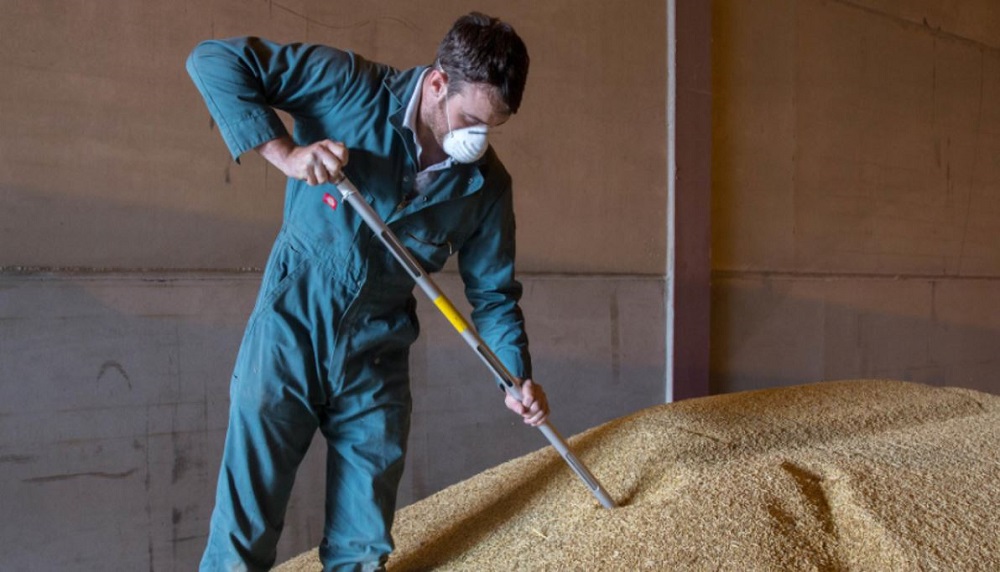- Home
- Knowledge library
- Grain sampling and monitoring during storage
Grain sampling and monitoring during storage
Grain remains a ‘living’ crop – it respires and is susceptible to infection by moulds and infestation by pests. To inform management, it is important to understand the quality and condition of grain.
An introduction to grain sampling
Guidance for the management of grain stores
In-store grain quality
Key quality parameters are assessed by trade-assured testing facilities, sometimes provided by a merchant or other independent testing laboratory. Parameters may include (depending on the market):
- Protein/nitrogen quantity
- Specific weight
- Hagberg Falling Number
- Germination
Most quality parameters do not change during storage. If effective sampling occurred at intake and the location of individual sampled loads (or lots) can be accurately identified within the store, such samples are sufficient for quality assessments.
In-store mycotoxin management
If grain has been harvested 'dry' or has been dried quickly, and is kept sufficiently dry in the store, storage mycotoxins (such as ochratoxin A) should not be a risk.
Legally, all producers must know whether grain destined for human consumption meets the food safety standards for the presence of the fusarium mycotoxins, DON, ZON, T2 and HT2.
Many processors require this information, especially at the start of each new harvest year. Samples taken in store may be used to provide this information.
Fusarium and microdochium in cereals
Management of storage pests
Although it is possible to draw physical samples from a bulk or bin for examination for storage pests, it is a laborious process. Traps are more than ten times more effective than sampling, especially at detecting low numbers of insects and mites.
For information on trapping, see our grain storage guidance
Grain sampling from static bulks
The best opportunity to generate representative grain samples is as stores are filled or from a dryer.
However, this is not always practical. As a result, it is sometimes necessary to sample grain bulks in flat stores. As always, it is important to follow best practice to ensure that final samples are representative of the bulk.
How to take incremental grain samples
Based on examples of industry practice and the relevant ISO standard (13690), a suggested minimum of 5 x 500 g incremental samples should be used to form a single (composite) final sample that represents no more than:
- 50 t for grain destined for human consumption (milling wheat, malting barley and food oats)
- 100 t for grain destined for feed
Use grain sampling spears to extract incremental samples from a static (i.e. not being moved by stirrers) bulk.
- Ideally, use a two-metre, multiple-aperture, spear capable of drawing a 500 g incremental sample
- Set the spear so apertures open in sequence, starting from the bottom compartment
- Insert the spear into the grain, at a slight angle from vertical with the slots facing upwards
- Turn the spear’s inner tube through 180° (which opens and closes the intake apertures) to collect a sample
- Use a grid system to take incremental samples that best represent the bulk. For example, from the front, middle and back of the heap or bay
How to make a representative grain sample
Good distribution of the incremental samples and thorough mixing of the composite sample is essential, so it is representative of the bulk. Place each final sample in a well-filled, clearly labelled and sealed bag. Analysis of such samples will provide growers and merchants with the most accurate view of the grain. Consult grain merchants for further guidance on how to sample grain accurately and safely.
How to make a composite (representative) sample
Monitoring moisture and temperature in stored grain
It is important to monitor the moisture content of grain. High moisture in stored grain promotes the development of moulds and mites. Certain moisture contents and temperatures also encourage the production of a storage mycotoxin – ochratoxin A. It it also critical to take regular recordings of grain temperature, as part of efforts to keep temperature/time targets on track, and identify hot spots associated with insect activity or water leaks.
For further details, see our guidance for the management of grain stores
Record keeping
Keep records of each monitoring activity to provide evidence of due diligence. As an alternative to time-consuming probing or sampling grain, fixed probes/sensors can be installed to monitor in-store conditions. The most modern installations enable constant remote monitoring (e.g. via a smartphone). Electronically recorded data also allows trends to be observed more easily.
 Tim Scrivener
Tim Scrivener

